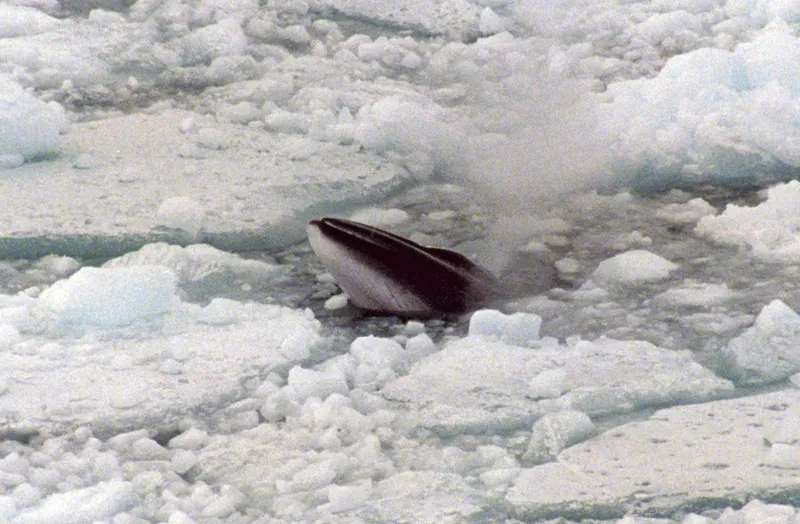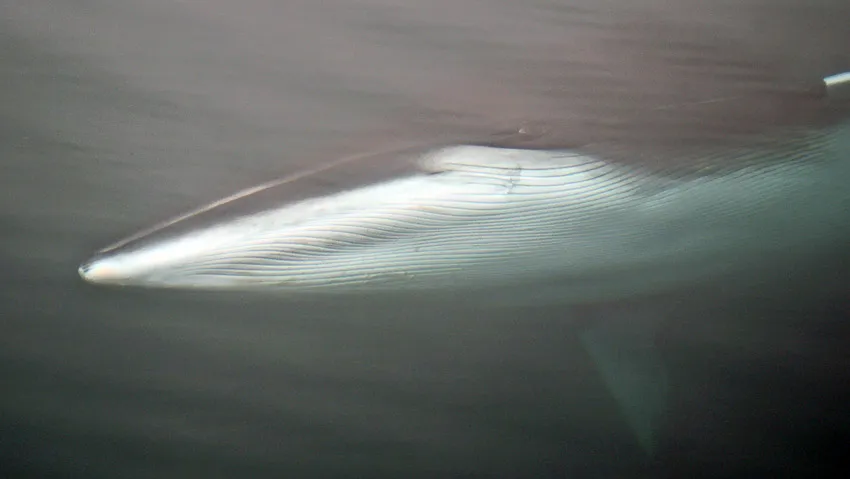Antarctic Minke Whale
Balaenoptera bonaerensis

Antarctic Minke Whale Statistics
Maximum length: 10.7m (35ft)
males / 9.8m (32ft) females
Adult weight: 15 tonnes
Life span: 30 - 50 years
Sexual maturity:
6 years males / 7 years females
Gestation: 10
months
Birth length: 2.4-2.8m (8-9ft)
Birth
weight: 400kg (882lbs)
Dive duration: 20 mins
Feed on: mainly krill
Predators:
may be an important prey for some Antarctic Killer Whales
Distribution: southern hemisphere only, summer months
mainly below 60°S to 65°S, while some remain in
Antarctica in the winter the proportion is not known and
many disperse to other places in the oceans of the southern
hemisphere.
Current world 800 000 / pre-whaling
- 200 000
Conservation status: Insufficient data
- Endangered to Least Concern

A minke whale blowing
through sea-ice in the Ross Sea
What used to be thought of as distinct northern hemisphere and southern hemisphere sub-species of minke whales have now been shown to be two different species. The northern species Balaenoptera acutorostrata (the "dwarf" minke whale) is slightly smaller than the Antarctic Minke Whale, Balaenoptera bonaerensis, While the northern species is sometimes found in Antarctica, the southern species is thought not to cross the equator.
As the smallest rorquals, minkes were the last to be exploited by whalers when the larger animals had been reduced to a level where they were no longer able to be profitably exploited, so the minkes were targeted as the species of last choice.
Minkes are fast swimming - over 20 kph, meaning that they are difficult to catch as well as being a relatively small catch.
Minkes are still hunted for "scientific" reasons by Japan, though large quantities of the meat turns up in very expensive restaurants and in markets. What is actually being "researched" is when it might be viable to resume active commercial whaling.
Ecology and behaviour
.webp) Like
other rorquals, minkes migrate to tropical or warm temperate
waters in the winter months and spend the summer months at higher
latitudes in polar waters where the long day length leads
to algal blooms in the sea and associated increases in
plankton and fish stocks means good a feeding time.
Like
other rorquals, minkes migrate to tropical or warm temperate
waters in the winter months and spend the summer months at higher
latitudes in polar waters where the long day length leads
to algal blooms in the sea and associated increases in
plankton and fish stocks means good a feeding time.
Minke whales are generally solitary animals or they are seen in pairs or threes. Larger groups are sometimes found in high latitudes in both hemispheres and groups may number 10 to 15 individuals. Minkes often approach boats, especially when stationary, and are notoriously inquisitive, as such they are more likely to be seen closely than other rorquals.
Picture credits: Banner at top of page, Maksim Sokolov used under CC-BY-SA-4 licence / Blowing through sea-ice, by brocken inaglory used under CC-BY-SA-3.0 licence / head of whale seen from surface, by 500px used under CC-BY-3.0 licence

